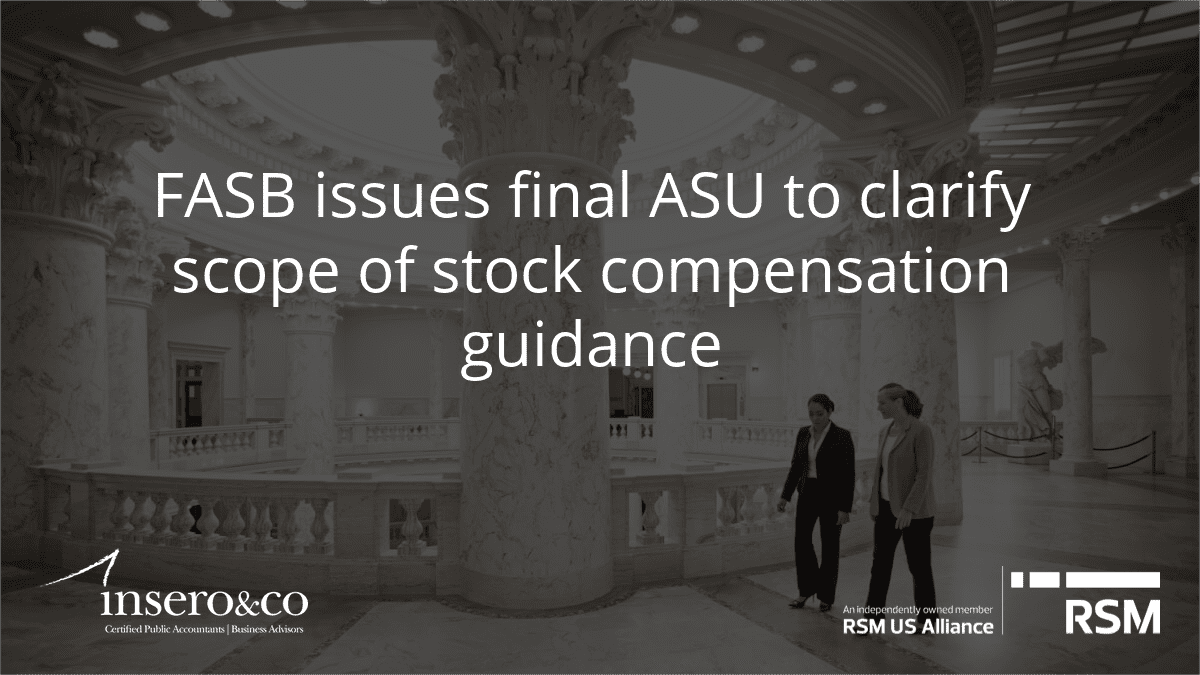INSIGHT ARTICLE |
Authored by RSM US LLP
Laid-off and furloughed employees
Before determining whether there is a partial plan termination, it is important to note the difference between laid-off employees and furloughed employees, two terms often used interchangeably, as whether an employee is considered laid-off or furloughed can have an impact on whether there is a partial plan termination.
A laid-off employee is a worker who has either lost or left their job because their employer has moved, closed or downsized, or because there is insufficient work. Layoffs are not usually related to employees’ performance or conduct. A laid-off employee is considered a terminated employee; however, it is possible for a laid-off employee to be rehired.
A furlough, however, is a mandatory leave of absence in which an employee is expected to return to work—in other words, furloughed employees are not considered terminated from employment. Furloughed employees are still considered active; they are just not on the work schedule.
Consult an attorney for additional guidance if there is any question about how an employee should be categorized, especially to find out if state-specific laws apply.
What is a partial plan termination?
A partial plan termination typically occurs when more than 20% of a plan’s participants are laid off in a particular year. The occurrence of a partial plan termination is determined by a facts and circumstances test. Although the IRS views a 20% reduction in participants as a significant percentage, there have been instances where courts found partial terminations to have occurred with lower turnover rates. Therefore, the specific facts and circumstance of each situation are crucial for understanding whether a partial plan termination has occurred.
To determine if the reduction in participants meets the 20% threshold, the sponsor must look at the span of the entire plan year and the turnover of participants during that time. The turnover rate is calculated by dividing the total number of employer-initiated terminations by the number of participants at the end of the plan year, then adding any new participants who entered the plan during the year.
A facts and circumstances analysis should be implemented if it is found that the employers’ average turnover rate over the past two or three years is higher than the 20% threshold. This would encourage employers to rebut an assumption of partial plan termination. In other words, if the employer normally would have a higher turnover rate specific to their business needs, the 20% threshold would not result in a partial plan termination.
What are the implications of a partial plan termination?
Vesting: If the plan did, in fact, meet the partial plan termination threshold, all participants who terminated during the plan year, regardless of whether the terminations were employer-initiated, must be fully vested in their accounts. This may mean restoring balances to terminated participants who were previously forfeited.
Existing plan forfeitures may be used to restore balances. However, if the plan forfeitures are not sufficient, the plan sponsor may have to consider additional contributions to make these participants’ accounts whole. This, of course, can have significant financial implications for the employer.
Examples
Company A has 10 employees. Company A let go four of its 10 employees (i.e., 40%) during the year. Since 40% is greater than the 20% required for a partial plan termination, Company A has a partial plan termination.
XYZ Company has 275 employees. Due to a gap in projects, the company furloughed 57 employees for approximately 30 days. All employees were expected to return to work at the end of the 30 days. XYZ Company does not have a partial plan termination because the furloughed employees were expected to return to work at a later date.
Acme Corporation has 50 employees. During the course of the year, 12 employees, or 24%, voluntarily terminated employment with the company. Generally speaking, Acme does not have a partial plan termination because voluntary terminations do not count in determining whether a partial plan termination occurred.
Partial plan terminations and COVID-19
One crucial question that has been weighing on plan sponsors’ minds is whether any relief will be granted from the partial plan termination rules for reductions due to COVID-19.
Recently, the IRS provided relief through a Q&A format on its website:
Q: “Are employees who participated in a business’s qualified retirement plan, then laid off because of COVID-19 and rehired by the end of 2020, treated as having an employer-initiated severance from employment for purposes of determining whether a partial termination of the plan occurred?”
A: “Generally, no. Subject to the facts and circumstances of each case, participating employees generally are not treated as having an employer-initiated severance from employment for purposes of calculating the turnover rate (defined in Revenue Ruling 2007-43, 2007-28 IRB) used to help determine whether a partial termination has occurred during an applicable period, if they’re rehired by the end of that period. That means participating employees terminated due to the COVID-19 pandemic and rehired by the end of 2020 generally would not be treated as having an employer-initiated severance from employment for purposes of determining whether a partial termination of the retirement plan occurred during the 2020 plan year.”
Summary
In summation, if employees were terminated due to COVID-19 but rehired by the end of 2020, they are not to be counted in determining the turnover rate. The Consolidated Appropriations Act, 2021, which was signed into law Dec. 27, 2020, provides a temporary rule preventing partial plan termination. The bill allows defined contribution retirement plan sponsors to avoid the partial plan termination rules if the active participant count as of March 31, 2021, is 80% of the active participant count on March 13, 2020. This will hopefully help some plans avoid partial plan terminations. If you have questions regarding this update or the rules regarding partial plan terminations, please contact your financial professional.
Do you have questions or want to talk?
Call us at (800) 232-9547 or fill out the form below and we’ll contact you to discuss your specific situation.
This article was written by RSM US LLP and originally appeared on 2021-02-12.
2020 RSM US LLP. All rights reserved.
https://rsmus.com/what-we-do/services/wealth-management/services-we-offer/retirement-plan-advisory/partial-plan-terminations-2020-and-covid-19.html
The information contained herein is general in nature and based on authorities that are subject to change. RSM US LLP guarantees neither the accuracy nor completeness of any information and is not responsible for any errors or omissions, or for results obtained by others as a result of reliance upon such information. RSM US LLP assumes no obligation to inform the reader of any changes in tax laws or other factors that could affect information contained herein. This publication does not, and is not intended to, provide legal, tax or accounting advice, and readers should consult their tax advisors concerning the application of tax laws to their particular situations. This analysis is not tax advice and is not intended or written to be used, and cannot be used, for purposes of avoiding tax penalties that may be imposed on any taxpayer.
RSM US Alliance provides its members with access to resources of RSM US LLP. RSM US Alliance member firms are separate and independent businesses and legal entities that are responsible for their own acts and omissions, and each are separate and independent from RSM US LLP. RSM US LLP is the U.S. member firm of RSM International, a global network of independent audit, tax, and consulting firms. Members of RSM US Alliance have access to RSM International resources through RSM US LLP but are not member firms of RSM International. Visit rsmus.com/aboutus for more information regarding RSM US LLP and RSM International. The RSM(tm) brandmark is used under license by RSM US LLP. RSM US Alliance products and services are proprietary to RSM US LLP.

Insero & Co. CPAs, LLP is a proud member of RSM US Alliance, a premier affiliation of independent accounting and consulting firms in the United States. RSM US Alliance provides our firm with access to resources of RSM US LLP, the leading provider of audit, tax and consulting services focused on the middle market. RSM US LLP is a licensed CPA firm and the U.S. member of RSM International, a global network of independent audit, tax and consulting firms with more than 43,000 people in over 120 countries.
Our membership in RSM US Alliance has elevated our capabilities in the marketplace, helping to differentiate our firm from the competition while allowing us to maintain our independence and entrepreneurial culture. We have access to a valuable peer network of like-sized firms as well as a broad range of tools, expertise, and technical resources.
For more information on how Insero & Co. CPAs can assist you, please call (800) 232-9547.




